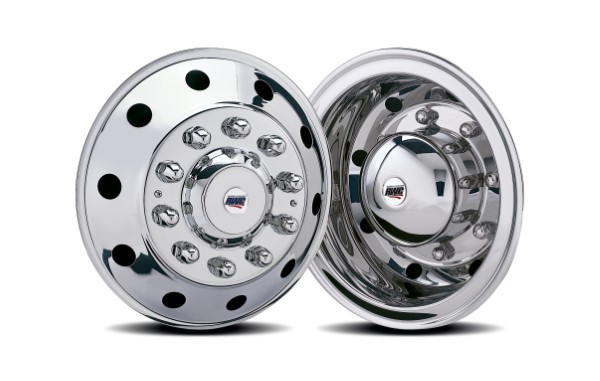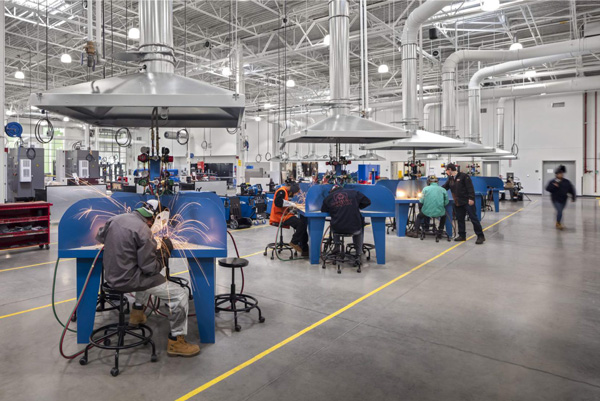Back in the late 1970s, Jan Polka wanted to burnish the look of the tractor-trailer he hauled gravel in. He cut up some sheet metal, spiffed it up with chrome and fitted out his rig with some shiny new wheel covers. He started getting looks. His truck, that is.
“People kept asking me on the CB radio, ‘Where’d you get those wheel covers?’ Polka recalls. “So, I started making them in my garage, and one thing led to another.”
He named his company RealWheels, its first two employees being himself and his wife Sherri. Today, the expanding enterprise founded in Lake County, Illinois, employs some three dozen workers and — seemingly on a dime — can crank out products from an ever-evolving catalogue of close to 3,000 items. Bumpers, fenders, hubcaps, door pulls, valve extensions, hood trim bezels, simulators. And, of course, the company’s bread and butter, those patented wheel covers.
“We make products for vehicles, pure and simple,” said Polka, whose chief lieutenants now include his sons Greg and Cory. “It’s gone way beyond the wheel accessories it all started from.”
Lake County, about halfway between Chicago and Milwaukee and bordered on the east by Lake Michigan, boasts a $20 billion manufacturing sector, “the largest contributor to our gross regional product,” according to Lake County Board Chair Sandy Hart. The county is big into pharmaceuticals manufacturing and hosts such global giants as Abbott, AbbVie, AkzoNobel and Baxter. But, for Lake County — which counts within its borders more than 600 manufacturing businesses — behemoths such as those are but the icing on the cake.
 RealWheels’ signature wheel covers.
RealWheels’ signature wheel covers.
Image courtesy of RealWheels
“Most of our manufacturing comes from small and medium-sized businesses like RealWheels,” said Ronald Lanz, business development director for Lake County Partners, a non-profit economic development organization.
Workforce Leads the Way
Like RealWheels, many of those smaller manufacturers power the Midwest automotive industry. And it’s the Lake County workforce, Lanz believes, that powers those manufacturers. Nearly 100,000 manufacturing workers account for one of the highest concentrations in the state, a county-wide manufacturing workforce that grew by 3.6% in 2023 alone. Manufacturing represents one out of every seven jobs.
“The biggest thing I hear from our businesses,” said Lanz, “is the strength of our workforce ecosystem, both the existing workforce itself — and the level of skills that are here currently — plus the ability to upskill employees to meet the needs of that advanced manufacturing sector. It’s what puts us over the top with a lot of these employers as to why they want to be here.”
The College of Lake County, with several locations, is the source of a sizable quotient of the region’s budding talent. The college’s crown jewel — Lanz calls it a “game changer”— is the recently opened Advanced Technology Center in Gurnee, a 170,000-sq.-ft. industrial education facility converted from a former Lowe’s. The Center offers instruction in industrial technology and automation, robotics, mechatronics and other emerging disciplines. Crucially, its administrators work hand-in-hand, Lanz says, with local manufacturers.
“They want to talk to companies very specifically and as early as possible,” he said, “to understand exactly the kind of training they need. And they are tailoring the curriculum based on those conversations and based on those needs to make sure that we have a workforce, not just today, but one that’s continuing to roll out indefinitely into the future.”
“The total economic impact of manufacturing on the state of Illinois is estimated to be between $580 billion and $611 billion annually.”
— Illinois Manufacturers Association
As to the growth of the region’s manufacturing sector, Lanz also credits Illinois’ state leadership for upping its game. Passed with bipartisan support by the Illinois legislature in 2021, the Reimagining Electric Vehicles in Illinois Act (REV) is a highly competitive incentives program created to attract companies along the EV supply chain. In 2023, Illinois doubled down, introducing a major expansion of clean energy incentives through Invest in Illinois, a $400 million closing fund available to major job creators.
“We have the incentives and the effort from the state, both for advanced manufacturing and the EV sector and now really moving into the data centers and the quantum sectors,” Lanz said. “That’s been the result of efforts put together by Governor Pritzker and the legislature.”
When officials in Wisconsin made a play to lure RealWheels across the bi-state border, Lake County and the City of Zion joined forces to retain the business as one of the region’s home-grown success stories. Lake County Partners helped to identify a site for RealWheels to expand and the city assembled an attractive incentives package.
“They just hopped to it and assisted in so many ways,” said Polka. “We felt like we were being taken care of so well. We wanted to stay here anyway, so it was win-win all around.”
The new RealWheels facility spans 65,000 sq. ft., big enough, Polka had hoped, to set up sons Cory and Greg for the day that he and Sherri retire.
“But,” he said, “we’re pretty much filling it up already. We’ll be needing more space.”
How Incentives Hit Home
REV and Invest in Illinois played major roles in what Gov. Pritzker has called “the most significant new manufacturing investment in Illinois in decades,” a $2 billion EV battery “gigafactory” planned for Kankakee County, south of Chicago. Gotion has committed to creating 2,600 jobs at the site of a former K-Mart warehouse in the city of Manteno. Gotion became the first-ever “Invest” recipient, an award of $125 million announced in September of 2023.
The State’s robust incentives also helped to secure a $500 million investment from Wieland Rolled Products North America. The expansion of Wieland’s East Alton facility, just north of St. Louis, will serve to retain 800 jobs while enabling the company to increase production of copper and copper alloy products, critical components in electric vehicles, EV charging infrastructure and renewable energy products. Wieland’s total incentive package from the State, which includes REV and other incentives, is valued at approximately $231 million and is the product of more than a year of public-private collaboration.
 The Advanced Technology Center at the College of Lake County.
The Advanced Technology Center at the College of Lake County.
Photo courtesy of Lake County Partners
“I’m incredibly grateful to Governor Pritzker and other officials,” said Greg Keown, the company’s president. “This is a shining example of how public-private partnerships are intended to work.”
Illinois also came through with an EDGE (Economic Development for a Growing Economy) tax credit to support a recent expansion by Georgia-based Gulfstream Aerospace that’s to create or retain some 700 jobs in Cahokia Heights. The $28.5 million expansion will bring Gulfstream’s total footprint at the city’s St. Louis Downtown Airport to 642,657 sq. ft., enabling it to increase capacity for exterior aircraft painting, furniture installations, avionics integrations and other operations, according to a release.
“We appreciate our partnerships with the state of Illinois, St. Clair County, Bi-State Development, the city of Cahokia Heights and the village of Sauget for their continued support as we grow our presence and local workforce in the region,” said Gulfstream President Mark Burns.

